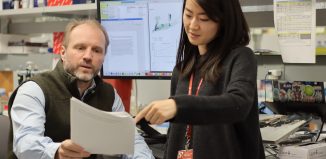Capturing another world
BNL’s rising star Haupt helps create complex camera
When Justine Haupt was a teenager, her mother had a camera that wasn’t working. “I can fix it,” Justine said. Her mother, Lorraine Labate, who recently became a substitute teacher’s assistant for BOCES, was skeptical. “It doesn’t work anyway,” she urged. “Can I have it?” Her mother found that logic hard to refute, so she gave the camera she didn’t expect to work again to her daughter.
Haupt discovered an electrical problem that prevented the film-advance motor from functioning and fixed it. That early curiosity came in handy for Haupt, who started out as an intern five years ago and is now a design engineer in the Instrumentation Division at Brookhaven National Laboratory. She is working on a camera that will have the largest lens and the largest sensor/detector array ever built.
Haupt is a part of a team that is developing the Large Synoptic Survey Telescope, which will allow astronomers to study dark matter, dark energy and asteroids that threaten to collide with Earth.
The LSST is a long-term project that includes numerous scientists at BNL, as well as other parts of the world. Ultimately, the camera for the LSST, which will find a home in Cerro Pachon in Chile at 8,800 feet, is expected to open its shutters for the first time in 2019 and will start its scientific survey around 2022.
Haupt earned distinction for her work this year, as Mouser Electronics and Design News named her the 2014 Rising Engineering Star. “She is exceptional in her engineering talent,” said Paul O’Connor, who is the head of the Instrumentation Group. “She also has a lot of outside interests, which I thought would be appealing” to the magazine.
Those interests include serving as a director-at-large for the Custer Institute in Southold, which is the oldest public observatory on Long Island. Haupt “did a lot of work with the instrumentation there,” O’Connor said. Her background in optics has been “very helpful” to his department at BNL, O’Connor said.
Haupt works with software she taught herself to use that allows her to print out three-dimensional images of her designs, O’Connor said. She can start with a concept in the morning and provide a finished product by the end of the day and has kept the department’s two three dimensional printers “running practically 24/7,” he added.
Haupt is specifically involved with optical, mechanical and thermal design for testing and prototyping a raft tower module. When 21 of these RTMs come together, that will form the final sensor array in the camera — or, as she puts it, the film.
There are portions of this raft that require precise mechanical alignment to preserve the image quality. The entire object lives in a vacuum because the sensors require low temperatures. The electronics, however, generate heat, so the thermal and mechanics have to be stable for the digital film part of the telescope to function without wearing down. Haupt said anything that’s put in the vacuum with the sensors has to be cleaned meticulously and handled carefully.
While Haupt’s role is in the creation of the telescope, she, like O’Connor, plans to follow the discoveries this tool will enable scientists to make in the world of astronomy and physics. “That’s part of why I look forward to coming to work,” she said. “I’m working on the instrument that we think will lead to the discovery of the mystery of dark matter. I will definitely be watching it closely.”
A Rocky Point High School graduate and current Rocky Point resident, Haupt has not only spent time thinking about the stars and helping create an instrument that will enable their study, but has also logged hours closer to them than many of her neighbors on the land-locked Long Island.
Until the last few years, she owned a 1947 Stinson Voyager, a single engine plane. She worked on the avionics for the plane.
Haupt’s grandfather, Daniel Labate, was a welder and had a machine shop in his basement. When Haupt was 5 or 6, her grandfather taught her how to use a lathe. He also showed her how to solder and got her involved with model railroads.
After they saw her success with a camera, Haupt’s parents gave her electronics that were no longer functioning, like VCRs. “I built up a big camera collection,” she recalled.






